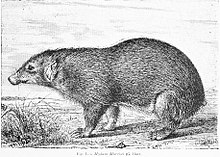| Palawan stink badger | |
|---|---|

| |
| Scientific classification | |
| Domain: | Eukaryota |
| Kingdom: | Animalia |
| Phylum: | Chordata |
| Class: | Mammalia |
| Order: | Carnivora |
| Family: | Mephitidae |
| Genus: | Mydaus |
| Species: | M. marchei
|
| Binomial name | |
| Mydaus marchei | |

| |
| Palawan stink badger range | |
The Palawan stink badger (Mydaus marchei), pantot or tuldo in the Batak language, is a carnivoran of the western Philippines named for its resemblance to badgers, its powerful smell, and the largest island to which it is native, Palawan. Like all stink badgers, the Palawan stink badger was once thought to share a more recent common ancestor with badgers than with skunks. Recent genetic evidence, however, has led to their re-classification as one of the Mephitidae, the skunk family of mammals.[3] It is the size of a large skunk or small badger, and uses its badger-like body to dig by night for invertebrates in open areas near patches of brush. While it lacks the whitish dorsal patches typical of its closest relatives, predators and hunters generally avoid the powerful noxious chemicals it can spray from the specialized anal glands characteristic of mephitids.
- ^ Widmann, P. (2015). "Mydaus marchei". IUCN Red List of Threatened Species. 2015: e.T14055A45201420. doi:10.2305/IUCN.UK.2015-4.RLTS.T14055A45201420.en. Retrieved 12 November 2021.
- ^ Huet, J. (1887). "Note sur une espece nouvelle de mammifère du genre Mydaus provenant de l'île Palaouan". Le Naturaliste. 2e série. 9 (13): 149–151.
- ^ Dragoo, J.W. & Honeycutt, R.L. (1997). "Systematics of mustelid-like carnivores". Journal of Mammalogy. 78 (2): 426–443. doi:10.2307/1382896. JSTOR 1382896.
